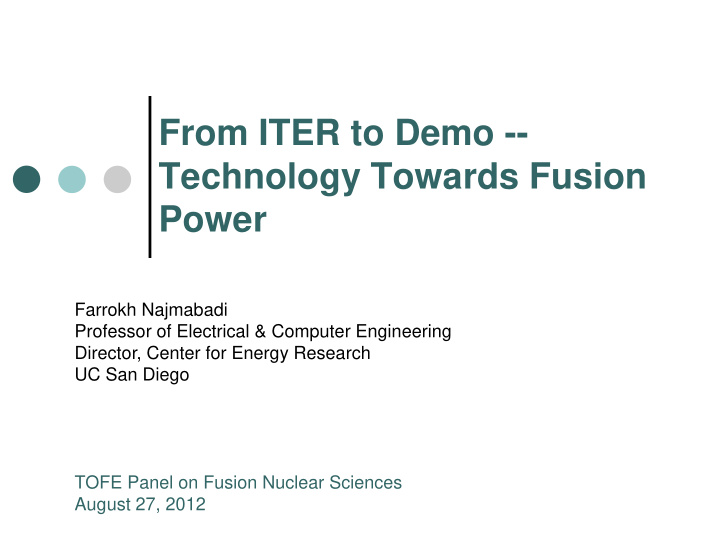



From ITER to Demo -- Technology Towards Fusion Power Farrokh Najmabadi Professor of Electrical & Computer Engineering Director, Center for Energy Research UC San Diego TOFE Panel on Fusion Nuclear Sciences August 27, 2012
Is there a case for a “unified” international road-map for fusion? Rationale for fusion development varies substantially around the world.
“World” needs a lot of energy! 400 US 350 300 Primary Energy per capita (GJ) Australia 250 France 200 150 S. Korea Japan 100 China 50 India 0 0 5,000 10,000 15,000 20,000 25,000 30,000 35,000 40,000 GDP per capita (PPP, $2000) With industrialization of emerging nations, energy use is expected to grow ~ 4 fold in this century (average 1.6% annual growth rate) * Data from IEA 2006 annual energy outlook (1980-2004)
“World” needs a lot of energy! US, EU, Japan: 400 US Electricity supply needs are 350 mainly for the replacement of existing power plants . 300 Primary Energy per capita (GJ) Australia Government regulations have 250 been driving the choice of France 200 energy supply. 150 Different level of access to S. Korea Japan indigence fossil fuels for 100 electricity production. China 50 Different socio-political India 0 atmospheres. 0 5,000 10,000 15,000 20,000 25,000 30,000 35,000 40,000 GDP per capita (PPP, $2000)
“World” needs a lot of energy! China, India, (S. Korea), …. 400 US Large supplies of Electricity is 350 needed to maintain economic 300 growth. Primary Energy per capita (GJ) Australia Governments actively following 250 France policies to expand energy 200 supply. 150 Different level of access to S. Korea Japan 100 indigence fossil fuels for China electricity production 50 Different socio-political India 0 atmospheres. 0 5,000 10,000 15,000 20,000 25,000 30,000 35,000 40,000 GDP per capita (PPP, $2000)
While current rationale for R&D differs, the ultimate goal would be the same. Fusion R&D expenditures are justified to government agencies who have different priorities and, therefore, respond to different “Roadmaps.” • Different R&D plans for the next decade. However, large-scale (multi-billion $) fusion facilities beyond ITER and NIF can only be justified in the context of their contribution to energy supply , i.e., commercial fusion. • Fusion roadmaps should include all R&D needed to achieve commercial fusion power. We will also have • Different Customers (e.g., Power Producers) • Different criteria for success (e.g., Commercial viability) • Timing (e.g., Is there a market need?)
Fusion Energy Development Focuses on Facilities Rather than the Needed Science Current fusion roadmaps which focus on “Demo” have a high probability of leading to lengthier and costlier programs (for commercial fusion). • Mission will be redefined to fit the “promised” time frame. • Cost, available data base, etc. will lead to further mission contraction, expanding the R&D needed after the next step and may also to un-necessary R&D. Recall ITER history (proposed in mid-80s, many revision of its mission, considerable expenditure, …). This is in contrast with the normal development path of any product in which the status of R&D necessitates a facility for experimentation.
Developing Fusion Power Technologies (FNS)…
Developing commercial fusion energy requires changes in our folklore: Fusion power technologies (fusion nuclear sciences) are in their early stages of development. We are NOT ready! Development of fusion nuclear sciences requires a large amount of resources. • We readily talk about multi-billion-$ plasma-based facilities but frown at $1B price tag of IFMIF. The perception that the only way to develop fusion nuclear technologies is to have 14-MeV neutrons is not correct (cook and look approach is very expensive and time-consuming) • A large potion of R&D can and should be performed in simulated environments (non-nuclear and/or fission test). • Fusion nuclear testing is needed only to validate the predicted performance plus all synergetic effects that were not foreseen. • 14-MeV neutron sources are NOT equal.
We should focus on developing a technical roadmap A detailed technical Road Map based on TRL methodology Includes what needs to be done (both critical and “non-critical”) Highlights the order they need to be done Includes clear mile-stones or check points showing progress Provides the justification for and the mission of needed facilities A times-less exercise that needs updating Such a Technical Roadmap provides the technical basis to develop policies and program portfolio. Allows flexibility in implementation scenarios (aggressive or slow) Allows multi-year program planning Provides a firm basis on cost/benefit analysis Provides a mechanism for “coordination” internationally and with plasma physics research.
Framework for technical roadmap Phase 1: Achieve TRL level 4 for all components (“Component and/or bench-scale validation in a laboratory environment) • Examples: demonstration of thermo-mechanical response of a blanket and divertor unit-cell, tritium extraction system in lab scale, fundamental material property demonstration and optimization. Phase 2: Achieve TRL level 6 for all component (“System/subsystem model or prototype demonstration in relevant environment.) • Examples: demonstration of an integrated full scale blanket/divertor module/sectors in non-nuclear (simulated environment). Demonstration of blanket/divertor unit-cell in fission environment. Phase 3: Achieve TRL level 7-8 for all components (“System prototype demonstration in an operational environment”) • Example: Validation in a fusion nuclear facility. Resolution of synergetic effects.
In summary … We need to develop a fusion energy technical roadmap (“Fusion Nuclear Sciences” road-map). • Large-scale facility should be only validation facilities. • Required science and engineering basis for any large facility should be clearly defined and included in such a Road-map. • We need to start implementing such a road-map to show that we are serious (only the “pace” is set by funding). • We need to start work-force development. Increased funding and emphasis for fusion have always been driven by external factors. • We need to be prepared to take advantage of these opportunities. • It is possible to field fusion power plant before 2050, but we lay the ground work now!
Thank you!
Recommend
More recommend